
Badger-baiting is a form of blood sport in which badgers [1] are baited with dogs. [2] A baiting session typically results in the death of the badger, and possibly serious injuries to the dogs.

Badger-baiting is a form of blood sport in which badgers [1] are baited with dogs. [2] A baiting session typically results in the death of the badger, and possibly serious injuries to the dogs.

The badger is a usually quiet and docile creature in its own domain; however, when cornered or threatened it can show great courage. Weighing up to 35 pounds (15 kg) when fully grown, the badger has an extraordinarily dangerous bite, which it is willing to use when threatened. In addition, badgers have extremely powerful claws, used for digging in hard earth, which are more than capable of injuring a dog. A formidable adversary for any dog, the badger was a sought-after victim for the fighting pit. [3]

In order to use the badger's ability to defend itself to test the dog, artificial badger dens were built, captured badgers were put in them and then the dog was set on the badger. The badger would be placed in a box, which was furnished in imitation of its den and from which a tunnel led upward. The owner of the badger puts his animal in the box.
The timekeeper is equipped with a watch and the badger's owner releases the dog for the fight. Whoever wants to pit his dog against the badger lets it slide into the tunnel. Usually the dog is seized immediately by the badger and the dog in turn grips the badger. Each bites, tears and pulls the other with all their might. The owner of the dog quickly pulls out the dog whose jaws are clamped obstinately onto the badger by its tail. The two are separated and the badger is returned to its den. Then the dog is sent back in to seize the badger and it again is drawn out with the badger. This scene is repeated over and over again. The more often a dog is able to seize the badger within a minute, so that both can be pulled out together, the more it is up to the task and is considered game.

Drawing the badger came to England in the 18th century and soon became a very popular sideshow in the pit. It provided a new opportunity to win or lose money by betting. Drawing the badger thus became a permanent part of the fight in the pit. Baits were staged outside the pit in cellars or taverns, as an interesting attraction for the guests.
Towards the middle of the 19th century, badger-baiting declined in popularity to be replaced by dog fighting.[ citation needed ]

Some dog breeds were specifically developed for badger-baiting whilst several other breeds were used in this task in addition to more general vermin control; breeds include the Dachshund [4] and terriers [5] like the bull and terrier [6] and the Jack Russell Terrier.
Apart from the cruelty towards badgers, dogs are also brutalized in the blood sport. Dogs usually suffer injuries to the face and neck. In some cases, the injuries are such that the dogs must be euthanized.
Today, baiters often refrain from taking injured dogs to veterinarians as the doctor might understand what has taken place and report the owners to the police. For this reason the badger is often crippled and/or restrained to minimise the risk of injury to dogs. The badger's long front claws may be filed off; the canine teeth may be pulled out; the animal's limbs or jaw may be broken with a shovel. To inhibit the badger's movement, there are rumours that the tendons in its hind legs may be cut. Griffiths et al. mention nailing badgers to the ground by the tail. [7] [8] [9]
When the badger can no longer fight, it is killed by the baiters using methods such as shooting, stabbing, or beating to death with a shovel. Dead badgers are sometimes dumped by the roadside to be mistaken for roadkill. [7]
Badger baiting was outlawed in the United Kingdom as early as 1835, with the Cruelty to Animals Act. The practice of baiting of animals is now specifically forbidden under the Protection of Animals Act 1911. [10] Furthermore, the cruelty towards and killing of the badger constitutes an offence under the Protection of Badgers Act 1992 [11] and further offences under this act are inevitably committed to facilitate badger-baiting, including interfering with a sett, or the taking or the very possession of a badger for purposes other than nursing an injured animal to health. If convicted, a person may face a sentence of up to six months in prison, a fine of up to £5,000 and other punitive measures, including, but not limited to: community service and a ban from owning a dog.
In the Republic of Ireland, badgers and their setts are protected under the Wildlife Act 1976 and Wildlife Amendment Act 2000.
Despite having been illegal for over 180 years, badger-baiting has continued in a clandestine manner throughout Britain and Ireland until the present day. In February 2009, The Sunday Times reported that badger-baiting is practised by "hardcore terrier men" who are internationally organized. The Sunday Times has also reported that there is little attention on the part of the Irish government towards animal cruelty in general. The report led to a police operation in Northern Ireland in which a number of dogs were seized, but no arrests were made. [12]
In the Republic of Ireland the NPWS has secured ten convictions for the illegal persecution of badgers in the last 20 years.
In 2009, badger baiting was believed to be on the rise according to animal welfare organizations. [13] Badger-baiting is often linked to other criminal activities, and some practitioners brag on social networks about their deeds.
In 2018, David Thomas of North Wales was sentenced to 22 weeks and his accomplice to 20 for setting dogs on badgers. [14]
Criminal gangs, among them Northern Irish paramilitaries, have been reported to sell badgers for up to £700 to fight with dogs. [15]

The dachshund, also known as the wiener dog or sausage dog, badger dog and doxie, is a short-legged, long-bodied, hound-type dog breed. The dog may be smooth-haired, wire-haired, or long-haired, with varied coloration.
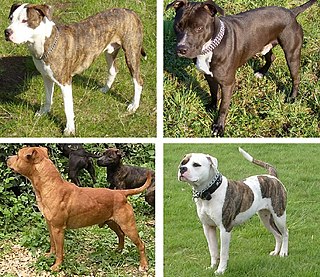
Pit bull is an umbrella term for several types of dog believed to have descended from bull and terriers. In the United States, the term is usually considered to include the American Pit Bull Terrier, American Staffordshire Terrier, American Bully, Staffordshire Bull Terrier, and sometimes the American Bulldog, along with any crossbred dog that shares certain physical characteristics with these breeds. In other countries, including the United Kingdom, the term is used as an abbreviation of the American Pit Bull Terrier breed specifically, while the Staffordshire Bull Terrier is not considered a pit bull. Most pit bull–type dogs descend from the British bull and terrier, a 19th-century dog-fighting type developed from crosses between the Old English Bulldog and the Old English Terrier.

The Staffordshire Bull Terrier, also called the Staffy or Stafford, is a purebred dog of small to medium size in the terrier group that originated in the northern parts of Birmingham and in the Black Country of Staffordshire, for which it is named. They descended from 19th-century bull terriers that were developed by crossing bulldogs with various terriers to create a generic type of dog generally known as bull and terriers. Staffords share the same ancestry with the modern Bull Terrier, although the two breeds developed along independent lines, and do not resemble each other. Modern Staffords more closely resemble the old type of bull terrier, and were first recognised as a purebred dog breed by The Kennel Club of Great Britain in 1935.

Bull-baiting is a blood sport involving pitting a bull against dogs with the aim of attacking and subduing the bull by biting and holding onto its nose or neck, which often resulted in the death of the bull.

Badgers are short-legged omnivores in the family Mustelidae. Badgers are a polyphyletic rather than a natural taxonomic grouping, being united by their squat bodies and adaptions for fossorial activity. All belong to the caniform suborder of carnivoran mammals.
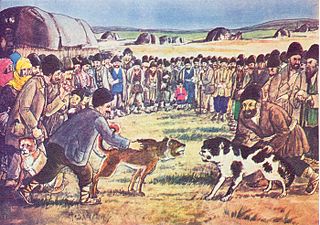
Dog fighting is a type of blood sport that turns game and fighting dogs against each other in a physical fight, often to the death, for the purposes of gambling or entertainment to the spectators. In rural areas, fights are often staged in barns or outdoor pits; in urban areas, fights are often staged in garages, basements, warehouses, alleyways, abandoned buildings, neighborhood playgrounds, or in the streets. Dog fights usually last until one dog is declared a winner, which occurs when one dog fails to scratch, dies, or jumps out of the pit. Sometimes dog fights end without declaring a winner; for instance, the dog's owner may call the fight.
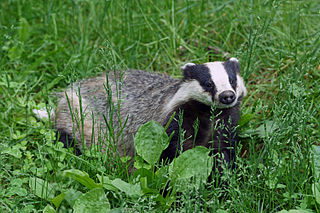
The European badger, also known as the Eurasian badger, is a badger species in the family Mustelidae native to Europe and West Asia and parts of Central Asia. It is classified as least concern on the IUCN Red List, as it has a wide range and a large, stable population size which is thought to be increasing in some regions. Several subspecies are recognized, with the nominate subspecies predominating in most of Europe. In Europe, where no other badger species commonly occurs, it is generally just called the "badger".

In law, breed-specific legislation (BSL) is a type of law that prohibits or restricts particular breeds or types of dog. Such laws range from outright bans on the possession of these dogs, to restrictions and conditions on ownership, and often establishes a legal presumption that such dogs are dangerous or vicious to prevent dog attacks. Some jurisdictions have enacted breed-specific legislation in response to a number of fatalities or maulings involving pit bull–type dogs or other dog breeds commonly used in dog fighting, and some government organizations such as the United States Army and Marine Corps have taken administrative action as well. Due to opposition to such laws in the United States, anti-BSL laws have been passed in 21 of the 50 state-level governments, prohibiting or restricting the ability of jurisdictions within those states to enact or enforce breed-specific legislation.

The Dangerous Dogs Act 1991 is an act of the Parliament of the United Kingdom prohibiting or restricting certain types of dogs and codifying the criminal offence of allowing a dog of any breed to be dangerously out of control. After a series of eleven dog attacks in 1991, Home Secretary Kenneth Baker promised "to rid the country of the menace of these fighting dogs". The Act has been controversial for failing to stem the rise of dog attacks and for focusing on a dog's breed or looks instead of an individual dog's behaviour.
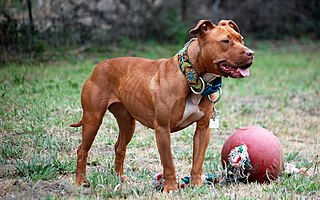
The American Pit Bull Terrier (APBT) is a dog breed recognized by the United Kennel Club (UKC) and the American Dog Breeders Association (ADBA), but not the American Kennel Club (AKC). It is a medium-sized, short-haired dog, of a solid build, whose early ancestors came from England. When compared with the English Staffordshire Bull Terrier, the American Pit Bull Terrier is larger by margins of 6–8 inches (15–20 cm) in height and 25–35 pounds (11–16 kg) in weight. The American Pit Bull Terrier varies in size: males are normally about 18–21 inches (45–53 cm) in height and around 35–60 pounds (15–27 kg) in weight, while females are normally around 17–20 inches (43–50 cm) in height and 30–50 pounds (13–22 kg) in weight.

Rat-baiting is a blood sport that involves releasing captured rats in an enclosed space with spectators betting on how long a dog, usually a terrier and sometimes referred to as a ratter, takes to kill the rats. Often, two dogs competed, with the winner receiving a cash prize. It is now illegal in most countries.

Bull and terrier was a common name for crossbreeds between bulldogs and terriers in the early 1800s. Other names included half-and-halfs and half-breds. It was a time in history when, for thousands of years, dogs were classified by use or function, unlike the modern pets of today that were bred to be conformation show dogs and family pets. Bull and terrier crosses were originally bred to function as fighting dogs for bull- and bear-baiting, and other popular blood sports during the Victorian era. The sport of bull baiting required a dog with attributes such as tenacity and courage, a wide frame with heavy bone, and a muscular, protruding jaw. By crossing bulldogs with various terriers from Ireland and Great Britain, breeders introduced "gameness and agility" into the hybrid mix.
Teastas Mor was a certificate of gameness issued to a dog by the Irish Kennel Club.

A working terrier is a type of terrier dog bred and trained to hunt vermin including a badger, fox, rat and other small mammals. This may require the working terrier pursuing the vermin into an underground warren. These working dog breeds are neither bred primarily for a dog show nor as a companion dog, rather they are valued for their ability to hunt, endurance and gameness. Working terriers provide utility on farms, for pest control and organized hunting activities. A terrierman leads a pack of terriers when they are working.

Dog fighting in the United States is an activity in which fights between two game dogs are staged as a form of entertainment and gambling. Such activity has existed since the early 19th century in the United States and was gradually prohibited in all states. It continues as an underground activity in both rural and urban locations.
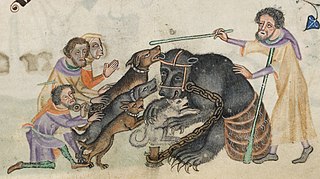
Bear-baiting is a blood sport in which a chained bear and one or more dogs are forced to fight one another. It may also involve pitting a bear against another animal. Until the 19th century, it was commonly performed in Great Britain, Sweden, India, Pakistan, and Mexico among others.
Dogs in the United States have significant popularity and status – they are often treated as family members. Currently, the American Kennel Club is the largest registry of pure breed dogs across the world.

The Gull Terrier is a rare breed of dog that originates from the Punjab region of Pakistan and India; it is believed to be several hundred years old. They are often used in dog fighting, hunting, and guarding. The Gull Terrier is a direct descendent of the Bull Terrier breed that came from Great Britain. These English dog breeds, along with those indigenous to the Indian subcontinent such as the Bully Kutta, played a major role in the Gull Terrier's breeding development and are considered to be a direct ancestor of the modern Gull Terrier. Old photographs of the English Bull terrier delineate many of the same features such as height pointy ears and a long muzzle of the Gull Terrier.
Fatal dog attacks are human victim's deaths caused by dogs. The study of fatal dog attacks can lead to prevention techniques which can help to reduce all dog bite injuries, not only fatalities. Dog bites and attacks can result in pain, bruising, wounds, bleeding, soft tissue injury, broken bones, loss of limbs, scalping, disfigurement, life-threatening injuries, and death.
The American Dog Breeders Association (ADBA) is an all-breed dog registry founded in 1909 by Guy McCord and Con Feeley. The registry is headquartered in Salt Lake City, UT in the U.S., but has multiple affiliate clubs located around the world. The registry began by promoting the John Colby strain of pit bull types. Over time, the focus changed to the registration and promotion of purebred American Pit Bull Terriers, a breed that few other breed registries have recognized because of its ancestral origins as a fighting dog in England and Ireland. The first official breed registry to recognize American Pit Bull Terriers was the United Kennel Club (UKC) in 1898 when it registered its first dog, "Bennett’s Ring", owned by UKC founder C. Z. Bennett. ADBA sponsors various conformation dog shows, weight pulling competitions, and Top Dog Athletic Events consisting of three canine competitions: treadmill race, wall climb and lure coursing. In 1976, ADBA began publishing a quarterly magazine titled The American Pit Bull Terrier Gazette.